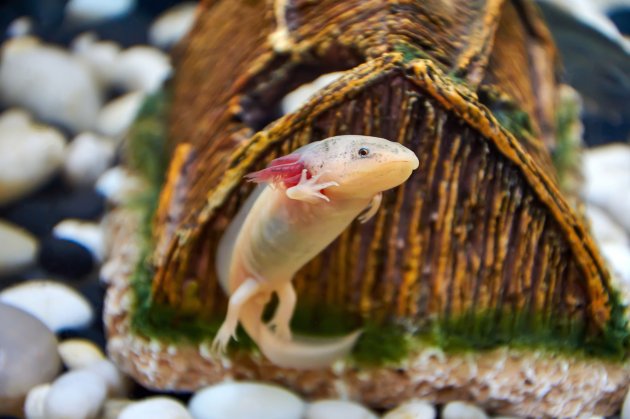You may have seen pictures of this super-cute “Mexican Walking Fish” making the rounds on social media - even if you aren’t a salamander fan, this little creature may change your mind.
This species is considered endangered because of the decline in its natural habitat - the canals leading into the Xochimilco Lake in Mexico. Fortunately, the axolotl has no problem being bred in captivity, so for this reason, it is becoming a popular aquatic housemate.
Let's discover the ins-and-outs of keeping an axolotl as a pet.

The Appearance of the Axolotl
The axolotl is a cute little salamander that can be found in a variety of colors; golden, black, yellow, albino, white with black eyes and other colors. It grows from 6 to 18 inches in length (although, over 12 inches is rare) and can live from 10 to 20 plus years.
This amphibian has short legs, with tiny toes on each foot. It also has a tail resembling that of a tadpole. However, perhaps the most interesting trait is its branch-like structures protruding from its head, which are actually gills that allow it to breathe underwater. Plus, who can resist that “nature-made” smile on its adorable little face?
Can You Keep an Axolotl as a Pet?
Since the axolotl is considered an exotic animal, you should check with your city’s by-laws to be sure you can legally own one. In the US, the axolotl is permitted in most states, except for California, Virginia, Maine, and New Jersey. They are also legal in New Mexico as a pet but illegal to export.
The axolotl is also a purely aquatic animal with a soft-body and permeable skin, therefore, they should not be handled unless absolutely necessary as this can lead to harming of the salamander.

The Personality and Temperament of the Pet Axolotl
The axolotl is a hardy pet and relatively tame. However, they are not social creatures and will not benefit from having an aquatic companion. In fact, they like to spend most of their time hiding/lounging amongst the plants and rocks as far below the surface of the water as possible. The only time the axolotl does move quickly or with “excitement” is during breeding season when the male and female will “dance” around the aquarium.
How Do You House a Pet Axolotl?
Because the axolotl has the potential to grow quite large, you will need at least a 15 to 20-gallon fish aquarium. Place the tank in an area that does not receive direct sunlight as the water temperature needs to be on the cooler-side (between 57 and 68 degrees Fahrenheit or 14 and 20 degrees Celsius). Do not allow the water temperature to get above 75 Fahrenheit (24 C) as this can be detrimental to the health of your salamander.
Axolotls do not need special lighting and, in fact, they enjoy being away from bright light, making good use of tank foliage or aquarium decorations to shade themselves with.
Place coarse aquarium gravel on the bottom of the tank - small gravel may be ingested and can cause a blockage, while bare-bottom tanks can stress your pet out because they cannot get a purchase on it.
Never place more than one juvenile axolotl in a single tank as they tend to be cannibalistic towards one another. Adults of this species may also attack each other, so keeping a single axolotl is best.
When using an aquarium filter in your axolotl tank, be sure it has a slow-flow. Powerful filters create a lot of suction and currents which is not healthy for the slow-moving axolotl. Additionally, the gill-branches on this creature’s head can also get trapped in the filter’s intake.
Lastly, tank maintenance will include doing a weekly water change (about 20 percent) using a gravel cleaner. Be sure to remove the chlorine from the fresh water before adding it to your axolotl’s habitat and that the ph level is maintained between 6.5 and 7.5 (neutral).

Feeding Your Pet Axolotl
In the wild, the axolotl is a carnivore and will dine on a variety of meat such as small fish, worms, crustaceans, snails, and small amphibians.
The captive axolotl can be fed;
- Bloodworms
- Tubifex worms
- Brine shrimp
- Small strips of beef or liver
- Frozen fish food
- Salmon and trout pellets
Note: Remove any uneaten food to help keep the tank clean.
Fun Axolotl Facts
Whether you keep an axolotl as a pet or not, they are still a fascinating creature. Check out these fun facts on the axolotl;
- This amphibian is considered neotenic, meaning it retains its juvenile features as an adult.
- It is a freshwater animal.
- Birds, like storks and herons, prey on the axolotl
- The axolotl can reach speeds up to 10 mph (15 kph).
- The axolotl does not undergo metamorphosis to reach adulthood.
- This amphibian can regenerate lost limbs and damaged organs and even parts of its brain.
- It can regrow a limb up to five times before it stops.
- Sometimes the axolotl will come to the surface to gulp some fresh air.
- This amphibian is 1,000 times more resistant to cancer than any other animal.
- The axolotl feeds using suction, not by chewing its food.
- Axolotl means “water dog.”
- Females can lay between 300 and 1,000 eggs at one time. Each egg is laid individually and placed on plants or rocks for protection.
The Axolotl & You
If the axolotl sounds like the right pet for you, do your research to find a reputable breeder or rescue organization. Know that these amphibians MUST be kept in aquatic habitat and it will require a protein-based diet. Having a healthy and happy axolotl can be a rewarding experience for the right person.
References and further reading:
- BBC Travel - Mexico City’s ‘walking fish’
- Lolly Brown (September 17, 2013) - Axolotl Facts & Information: A Complete Pet Owner's Guide.
- General axolotl care and health checks